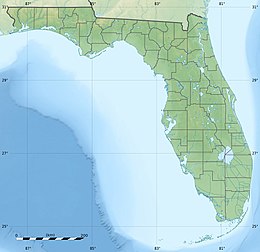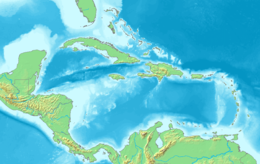Key Largo
 Key Largo | |
 Key Largo Key Largo | |
| Geography | |
|---|---|
| Location | Gulf of Mexico |
| Coordinates | 25°05′11″N 80°26′50″W / 25.0865°N 80.4473°WCoordinates: 25°05′11″N 80°26′50″W / 25.0865°N 80.4473°W |
| Archipelago | Florida Keys |
| Adjacent bodies of water | Florida Straits |
| Administration | |
| State | Florida |
| County | Monroe |


Key Largo (Spanish: Cayo Largo) is an island in the upper Florida Keys archipelago and is the largest section of the Keys, at 33 miles (53 km) long. It is one of the northernmost of the Florida Keys in Monroe County, and the northernmost of the Keys connected by U.S. Highway 1 (the Overseas Highway). Its earlier Spanish name was Cayo Largo,[1] meaning long islet.
Key Largo is connected to the mainland in Miami-Dade County by two routes. The first route is the Overseas Highway, the southernmost portion of U.S. Highway 1, which enters Key Largo at Jewfish Creek near the middle of the island and turns southwest. The second route is Card Sound Road, which connects to the northern part of Key Largo at Card Sound Bridge and runs southeastward to connect with County Road 905, which runs southwest and joins U.S. 1 at about mile marker 106. These routes originate at Florida City on the mainland.
Key Largo is a popular tourist destination and calls itself the "Diving Capital of the World" because the living coral reef a few miles offshore attracts thousands of scuba divers and sport-fishing enthusiasts.[2]
In 1870 a Post Office was established at "Caya Largo" (in the current Rock Harbor area). It closed and another was opened called "Largo" in 1881. Additional Post Offices opened in Planter in 1891 and Aiken in 1895.[3]
Key Largo's proximity to the Everglades also makes it a premier destination for kayakers and ecotourists. Automotive and highway pioneer and Miami Beach developer Carl G. Fisher built the Caribbean Club in 1938 as his last project.
The island gained fame as the setting for the 1948 film Key Largo, but apart from background filming used for establishing shots,[4][5] the film was shot on a Warner Brothers sound stage in Hollywood.[6] After the film's success, pressure from local businesses resulted in a change in the name of the post office serving the northern part of the island, from "Rock Harbor" to "Key Largo", on June 1, 1952. After that, every resident north of Tavernier had a Key Largo address and the postmark read "Key Largo".[7]
Three census-designated places are on the island of Key Largo: North Key Largo, near the Card Sound Bridge, Key Largo, eight or nine miles from the southern end of the island, and Tavernier, at the southern end of the island. As of 2010, the three places have a combined population of 13,850. None of Key Largo is an incorporated municipality, so it is governed at the local level by Monroe County.
Key Largo is situated between Everglades National Park to the northwest and John Pennekamp Coral Reef State Park to the east, the first underwater park in the United States, which protects part of the Florida Reef, the only living coral barrier reef in the continental United States.
Geology and geography[]
The island of Key Largo is an exposed, fossilized remnant of a coral reef formed during a period of higher sea level and then uncovered and eroded during a subsequent ice age. The highest elevation is a slight ridge forming the spine of the island, which rises to about 15 feet (4.6 m).
The island's substrate is called Key Largo limestone; in many places, fossilized corals and smooth, eroded limestone "caprock" are visible at the surface. Solution holes, which are pockets dissolved in the limestone by acidic rainwater, form shallow depressions in the land. The natural shoreline of the island is generally rocky. A slippery, gray, limestone-based clay called "marl" is the shoreline and near-shore soil. There are no natural sand beaches on the island. Inland, decomposed vegetation forms a rich, acidic humus soil up to about six inches thick, topped by "leaf litter". The soil supports a diverse flora of herbaceous plants, woody shrubs and hardwood trees.
Key Largo's climate is tropical (Aw or tropical savanna in Köppen climate classification). Frost has never been recorded on the island. Key Largo enjoys close to 3,000 hours of sunshine annually.
Climate[]
Key Largo has a tropical savannah climate (Aw).
| ||||||||||||||||||||||||||||||||||||||||||||||||||||||||||||||||||||||||||||
References[]
- ^ [1] Archived September 3, 2006, at the Wayback Machine
- ^ "All About Diving in the Florida Keys, Florida Keys Scuba Diving". Flkeys-diving.com. 1997-07-01. Retrieved 2015-06-26.
- ^ Wilkinson, Jerry. "History of Key Largo". keyshistory.org. Historical Preservation Society of the Upper Keys. Retrieved 16 November 2017.
- ^ "Key Largo Filming Locations". IMDb.com. Retrieved 2015-06-26.
- ^ "The Florida Keys: Key Largo". Goflorida.about.com. Retrieved 2015-06-26.
- ^ "Key Largo". Moviediva.com. Retrieved 2015-06-26.
- ^ Jerry Wilkinson. "keylargopage2". Keyshistory.org. Retrieved 2015-06-26.
- ^ "NASA Earth Observations Data Set Index". NASA. Retrieved 30 January 2016.
Further reading[]
- Lassman, Valerie (1989). "Key Largo letter drop" (PDF). South Florida History Magazine (3). pp. 12–3. Archived from the original (PDF) on 2019-04-12. Retrieved 2017-11-16 – via HistoryMiami.
External links[]
| Wikimedia Commons has media related to Key Largo, Florida. |
 Key Largo travel guide from Wikivoyage
Key Largo travel guide from Wikivoyage- Official Tourism Site
- Islands of Monroe County, Florida
- Islands of the Florida Keys
- Islands of Florida
- Key Largo

